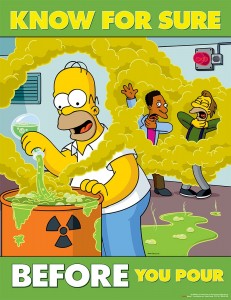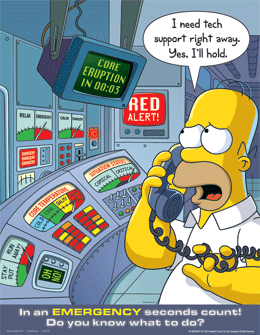What to do in an emergency in the ANF?
Can you imagine trying to reach the ANF manager while something is burning your hands? Or worse, your eyes? Please take a moment to read the following.
A warning to us all:
Dangerous processes can only be performed under the “BUDDY SYSTEM”.
- A process is deemed dangerous if it involves strong acids and bases, produces fumes and gases that are hazardous to health (if unsure, discuss with ANF staff)
- A BUDDY is someone PHYSICALLY present in the cleanroom with you
- Someone who knows enough to assist you in case of an accident (walk you to the eyewash/shower station, rinse your contaminated gloves before you touch other things, call for help).
- You must wear the full PPE (blue apron, green chemical gloves, faceshield); the faceshield may be optional as long as you perform all work protected by the wetbench sash AND you are wearing safety glasses
- The buddy is not required to wear the PPE but MUST know that you are performing potentially dangerous work (ie if you “find” a buddy in the cleanroom, make sure they know and agree to their roles)
Out of hours access (Regular hours are 8:00am to 6:00pm; Out of hours access can be granted to experienced users):
- Send an email to qmi-anf@ampel.ubc.ca with your request (request is automatic unless denied if you are an experienced user)
- Dangerous processes under the BUDDY system but highly discouraged out of hours
- ALL “safe” work require a REMOTE BUDDY:
- A Remote Buddy is someone with full access to the building and the cleanrooms (ie, a qualified cleanroom user)
- The Remote Buddy knows what time you are in the nanofab and can contact you at any time (eg text, email, phone)
- The Remote Buddy is to be advised when you leave the nanofab (and is expected to check on you if you fail to do so)
Safety Videos:
- Information video on the dangers of HF
- Information video on eye injuries (disturbing)
- UCSD lab safety presentation (geeky but very good)
- How to use a safety shower (Note: the importance of a buddy)
- Lab safety video (funny: what NOT to do)
- University of Texas safety training course.
- Top 10 science lab safety rules (most still apply to our lab)
Some Hydrofluoric Acid Facts (our most dangerous chemical):
Emergency exits and interlock overide switches
There are at least 2 exits from each of the cleanroom modules.
Break switches:
- With the exception of the white room exit, there are blue break switches next to all exit doors (similar to a fire alarm switch but blue instead of red). When you need to exit in a hurry, don’t fumble with the light sensors, just pull the blue switch and exit.
Vestibule exit:
- Best to head back out into the Brimacombe hallway in most cases. Do not fumble with your FOB to exit the vestibule. Instead, pull the blue break switch.
- In the very unlikely event that the hazard is in the hallway next to the vestibule door, exit through the gowning room, air shower and white room double doors (pull the blue switch and don’t fumble with light sensors)
ISO-5 yellow room exit (the one with the maskless aligner):
- Single door into ISO-6 yellow room and
- Double doors to the entrance vestibule (push the handle).
ISO-6 yellow room exit (the one with the contact mask aligner):
- Single door into the white room next to the air shower and
- Double doors into the white room at the south end of the room.
ISO-6 white room exit:
- Best is to use the double doors into the Brimacombe hallway or
- Single door through the air shower (pull blue break switch)
- Any of the 2 doors through the ISO-6 yellow room, then ISO-5 yellow room and to vestibule
Air shower exit:
- Door into the white room then out to corridor and
- Door into gowning room then through vestibule.
Gowning room exit:
- Best is through door into the entrance vestibule or
- door through the air shower then white room.
Types of emergencies that can arise in the ANF
- Alarm sounds
- Small contained chemical spill
- Medium to large or uncontained chemical spill
- Chemical spill on person (protective equipment, body, eyes)
- Injury
Required Actions
 First, unless you know the source of the emergency or the extent of the injury, treat any alarm, spill or injury as potentially life threatening or potentially leading to lifelong disability. Of course, in most cases this will not be the case but better safe than sorry
First, unless you know the source of the emergency or the extent of the injury, treat any alarm, spill or injury as potentially life threatening or potentially leading to lifelong disability. Of course, in most cases this will not be the case but better safe than sorry
Alarms
There are several alarms that can sound or be heard inside the ANF cleanrooms: the main building fire/evacuation alarm, and the toxic gas alarm. Never enter the cleanrooms if any alarm is active.
- In the case of the main building evacuation alarm, leave your work and exit the ANF cleanrooms in an orderly manner, through the nearest emergency exit and proceed to the nearest building exit. You are NOT to degown, pick up jackets/notes or anything. Treat the evacuation alarm as you would if you were in any other lab or office. The floor fire marshall will do a walk around the lab to make sure all doors are closed and everyone is out.
- Toxic gas alarm. We currently do not have any toxic gases in the cleanroom but we will have at least ammonia in the near future so please treat a toxic gas alarm as real. Evacuate the lab immediately through the nearest exit. Do not worry about degowning; just get out of there ASAP!!!!! Report the problem to ANF staff.
- User activated evacuate alarm. TBD
Small contained chemical spills.
- These are usually small spills fully contained in the wetbenches. The procedure for dealing with these is explained in the wetbench SOP and should be part of your wetbench training/qualification.
Medium to large or uncontained chemical spill
- This can be a beaker of acid/base dropped on the floor or even a large quantity of a normally safe chemical like iso-propanol. Any chemical that can contaminate your cloths or that release fumes should be at a minimum treated as toxic and, at worse, potentially life threatenning or life disability. For instance, strong fumes from acids or bases can permanently damage lungs and eyes while a large quantity of acetone, chloroform or propanol will cause you to faint and die of asphyxiation.
- What to do? Evacuate the lab immediately through the nearest exit. Do not worry about degowning; just get out of there ASAP!!!!! Report the problem to ANF staff.
Chemical spill on person (protective equipment, body, eyes)
- This can only happen in cases where a buddy is present in the cleanrooms (see description below).
- First, make sure you know where to find: eyewash station, acid shower, first aid kit, calcium gluconate gel.
- eye wash stations in gowning room and white room near glassware washer
- acid showers in gowning room and whiter room near glassware washer
- First aid kit in vestibule (contains calcium gluconate gel)
- Calcium gluconate gel tube taped to white room wetbench
- Spill on protective equipment (gloves, apron, faceshield). Work as a team with your buddy. Use the DI water tap activated by the foot pedal. There is a sink next to the glassware washer with domestic water. Taking care not to spread the contamination, get the contaminated equipment to this sink and rinse it thoroughly. Small spills on apron can be wiped with water soaked wipes. If the contaminated equipment is too big throw the contaminated equipment in the domestic water sink. Report the problem to ANF staff.
- Spill on body. Again, work as a team. Get the contaminated person to a water source ASAP!! Rinse the area thoroughly with water, minimum of 15 minutes for acids and 30 minutes for bases (eg KOH, TMAH). Determine if a 911 call is necessary; if unsure, call 911! Report to ANF staff as soon as possible. Here is a video showing what to do. And another good video for large spill on body.
- If the spill/splash involved a solution containing hydrofluoric acid, after rinsing for a minimum of 15 minutes generously apply the calcium gluconate gel to the affected area and go to the hospital (just across the street on Wesbrook Mall). There is a tube of gel in the ziplok on wetbench and a second tube in the first aid kit.
- Spill in eyes. Bring the injured body to the eyewash station promptly. If she/he wears contacts they must be removed asap otherwise the water will not rinse the contaminant from the eyes. Keep rinsing for at least 15 minutes for acid splash (same for solvent splash) and 30 minutes for basic (alkaline) splash. Call 911 and get ambulance to carry person to hospital. Report the incident to ANF staff.
(Last update: March 13, 2024)
